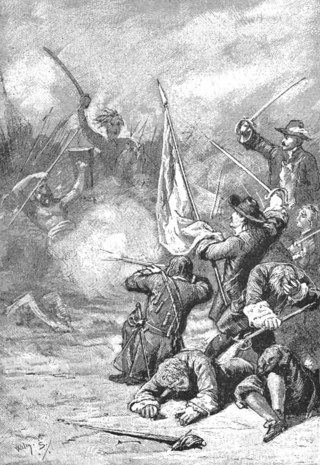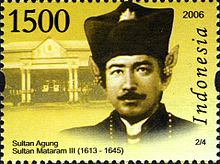
Madura Island is an Indonesian island off the northeastern coast of Java. The island comprises an area of approximately 4,436.77 square kilometres (1,713.05 sq mi). Administratively, Madura is part of the province of East Java. It is separated from Java by the narrow Madura Strait. The administered area had a density of 755.6 people per km2 in mid-2023, while the main island had a somewhat higher figure of 840 per km2.

The Sultanate of Mataram was the last major independent Javanese kingdom on the island of Java before it was colonised by the Dutch. It was the dominant political force radiating from the interior of Central Java from the late 16th century until the beginning of the 18th century.

Sultan Agung Adi Prabu Anyakrakusuma, commonly known as Sultan Agung, was the third Sultan of Mataram in Central Java ruling from 1613 to 1645. He was a skilled soldier who conquered neighbouring states and expanded and consolidated his kingdom to its greatest territorial and military power.

Amangkurat I was the susuhunan of the Mataram Sultanate from 1646 to 1677.

Amangkurat II was the susuhunan of the Sultanate of Mataram from 1677 to 1703. Before taking the throne, he was the crown prince and had the title Pangeran Adipati Anom.
Sunan Kalijaga was one of the "nine saints" of Javanese Islam. The "Kalijaga" title was derived from an orchard known as "Kalijaga" in Cirebon. Other accounts suggest that the name derives from his hobby of submerging himself in Kali. Others note that the name Kalijaga derived its nature from the Arabic notion of qadli dzaqa which means "holy leader" in the sultanate.

The Demak Sultanate was a Javanese Muslim state located on Java's north coast in Indonesia, at the site of the present-day city of Demak. A port fief to the Hindu-Buddhist Majapahit kingdom thought to have been founded in the last quarter of the 15th century, it was influenced by Islam brought by Muslim traders from China, Gujarat, Arabia and also Islamic kingdoms in the region, such as Samudra Pasai, Malacca and Bani (Muslim) Champa. The sultanate was the first Muslim state in Java, and once dominated most of the northern coast of Java and southern Sumatra.

The Sultanate of Cirebon was an Islamic sultanate in West Java founded in the 15th century. It is said to have been founded by Sunan Gunungjati, as marked by his letter proclaiming Cirebon's independence from Pajajaran in 1482, although the settlement and the polity had been established earlier, in 1445. Sunan Gunungjati also established the Sultanate of Banten. It was one of the earliest Islamic states established in Java, along with the Sultanate of Demak.

The siege of Batavia was a military campaign led by Sultan Agung of Mataram to capture the Dutch port-settlement of Batavia in Java. The first attempt was launched in 1628, and the second in 1629; both were unsuccessful.
Pakubuwono I, uncle of Amangkurat III of Mataram was a combatant for the succession of the Mataram dynasty, both as a co-belligerent during the Trunajaya rebellion, and the First Javanese War of Succession (1704–1707).

The eastern salient of Java is a region that makes up the easternmost part of the island of Java, Indonesia. It is not a formal or administrative subdivision, but rather a designation often used to refer to its distinct history, culture, and geographical feature. It is generally considered to begin in the Tengger mountain range and extend eastwards to the east coast of Java. It is entirely contained by the Indonesian province of East Java.
The Duchy of Surabaya was a Javanese principality centered in Surabaya, on the northeastern coast of Java, that existed as an independent polity from c. 1546 to 1625. It became independent following the disintegration of the Demak Sultanate, and by the beginning of the 17th century had become the leading power in east Java and the most important port on Java's northeastern coast. Subsequently, it entered into decades of conflict with the Mataram Sultanate that ended in the victory of Mataram and the fall of Surabaya in 1625.

The Trunajaya Rebellion or Trunajaya War was the ultimately unsuccessful rebellion waged by the Madurese prince Trunajaya and fighters from Makassar against the Mataram Sultanate and its Dutch East India Company (VOC) supporters in Java during the 1670s.

The Fall of Plered was the capture of the capital of the Mataram Sultanate by the rebel forces loyal to Trunajaya in late June 1677. The attack on Plered followed a series of rebel victory, notably in the Battle of Gegodog and the fall of most of Mataram's northern coast. The aged and sick King Amangkurat I and his sons offered an ineffective defense, and the rebel overran the capital on or around 28 June. The capital was plundered and its wealth taken to the rebel capital in Kediri. The loss of the capital led to the collapse of the Mataram government and the flight of the royal family. The king fled with his son the crown prince and a small retinue to Tegal and died there, passing the kingship to the crown prince, now titled Amangkurat II, without any army or treasury.
The Battle of Gegodog took place on 13 October 1676 during the Trunajaya rebellion, and resulted in the victory of the rebel forces over the Mataram army led by the Crown Prince Pangeran Adipati Anom. Gegodog is located in the northeastern coast of Java, east of Tuban.
After his victory at the Battle of Gegodog in northeast Java, the Madurese rebel leader Trunajaya proceeded westwards to conquer Mataram Sultanate's remaining towns on the north coast of Java. By January 1677, nearly all coastal towns from Surabaya to Cirebon were taken.
Pangeran Pekik was a Javanese prince, and son of the last Duke of Surabaya, Jayalengkara. After the Mataram conquest of Surabaya, he was forced to live in Mataram court. He was executed in 1659 under the orders of Mataram's King Amangkurat I, who suspected him of conspiracy.

In a campaign that took place from August to December 1678 in Kediri during the Trunajaya rebellion, the forces of the Mataram Sultanate, led by Amangkurat II, and the Dutch East India Company (VOC), led by Anthonio Hurdt, marched inland into eastern Java against Trunajaya's forces. After a series of marches beset by logistical difficulties and harassment by Trunajaya's forces, the Mataram–VOC army crossed the Brantas River on the night of 16–17 November. They then marched on Trunajaya's capital and stronghold at Kediri and took it by direct assault on 25 November. Kediri was plundered by the Dutch and Javanese victors, and the Mataram treasury—captured by Trunajaya after his victory at Plered—was completely lost in the looting. Trunajaya himself fled Kediri and continued his greatly weakened rebellion until his capture at the end of 1679.
Panembahan Senapati, formally styled Panembahan Senapati ing Ngalaga Sayyidin Panatagama, was the founder of the Mataram Sultanate.

Giri Kedaton was an Islamic kedatuan located in Gresik, East Java and existed in the 15th to 17th centuries, until Giri was conquered by the Mataram Sultanate in 1636.















